Last Updated on June 20, 2024 by Michelle
This homesteading thing is hard y’all. Rewarding? Absolutely. Impossible? Some days.
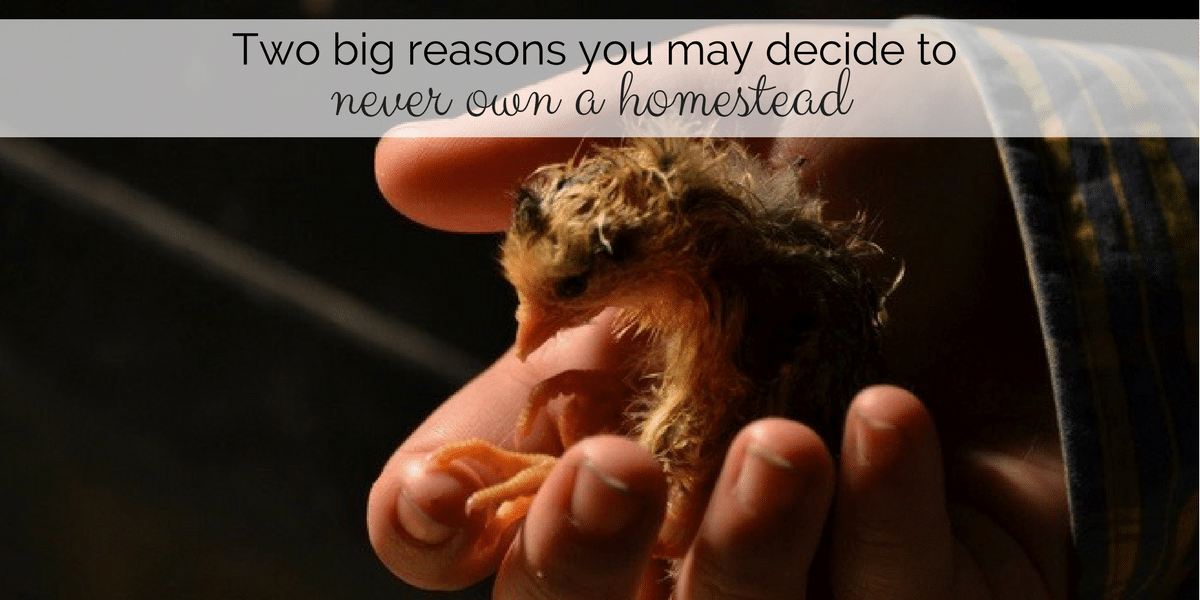
If I’m feeling honest, I will admit my frustrations to anyone who asks. (Scratch that… I’ll unload and border on whining some days…)
I’ve had many moments over the last 3 years of homesteading when I considered throwing in my muck boots. I don’t mean those times when I threw up my hands and yelled out loud, scaring poor Bixby–my loyal labradoodle who is always by my side–in the process. No those moments happen pretty often, but they’re momentary, because most days I genuinely love what I do.
If you’d like to know the whole process of how I trained my dog to be kind to my free-ranging chicken, I explained that in great detail in this post.
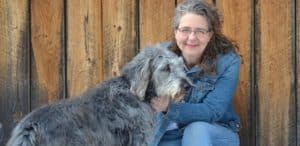
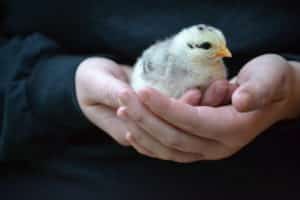
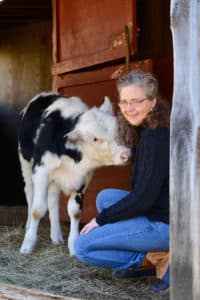
But there are those distinct times, that I remember well, when I logically thought through the process of how I could quit this ride. Get off the homesteading bus all together. Give away the animals and move to a new little house close to town. Every one of those specific times always revolved around one of two situations. One is the topic of today’s post. The other you can read here.
Death is One Painful, Difficult Aspect of Homesteading
I’m not thinking of the animal processing when I mention the death that disheartens me.
I’m a farm girl at heart.
I grew up in the home of a country boy and a farm girl who grew up on poor family farms during the Depression. Mom and Dad moved to midAtlantic suburbia when they were young newlyweds. They traded in daily milking, acres of hand plowing, and annual hog butchering for a tidy little home on 1/10 an acre of a fenced-in, well-manicured square of Kentucky bluegrass, a small rectangle of a vegetable garden, and a 5-minute commute to 3 different brightly-lit, fancy-tiled grocery stores.
I understand all homesteads inherently involve death.
Yes, even as a child I was acquainted with the reality that animals must die in order for us to eat. My favorite childhood memories revolve around my granddad’s old farmhouse with the enclosed, narrow, windy stairs that led to the chilly room I shared with cousins every Thanksgiving, because it was deer hunting season, and occasionally again in the spring, because it was butchering season. After the hunters had a successful day in the fall, we would all gather in my uncle’s cinder-block basement to process the meat.
I have wonderful childhood memories on my granddad’s old farm. But I didn’t realize I was a part of was a quickly dying, self-sustaining way of life.

In the spring I loved watching the entire process from beginning to end of how a pig that had been given a good life then provided delicious food for my uncle’s family all year long. (That’s 8- or 9-year-old me behind my grandmom’s wood stove in the farmhouse kitchen, where many a rabbit stew provided great, welcome nutrition to a family of 10 kids in the country.)
I’m truly in favor of good, profitable death on a homestead, if it’s done well, with thanksgiving to the Creator and with respect to the animal.
It is very sad to me to see animals die from a defect or problem at birth, that’s not the death I’m referring to either.
We’ve nurtured baby rabbits successfully when a young momma didn’t allow them to nurse and seen them grow into healthy thriving adults. But we’ve also spent many hours dropper-feeding a sweet newborn bunny who died even after tender care.
I helped my daughters care for and nurse the premie all afternoon after its momma seemed to be rejecting it. In the night, the momma finished preparing her nest and gave birth to many more; she then took this little one back under her care but it died a few days later.
We spent a long night wrapping the deformed, splayed leg of a chick and helping her stand and learn to bear weight on her wrapped foot. She learned within hours and grew to adulthood.
But we have also anxiously watched more than one baby chick die within a day or two of birth from neck and leg deformities.
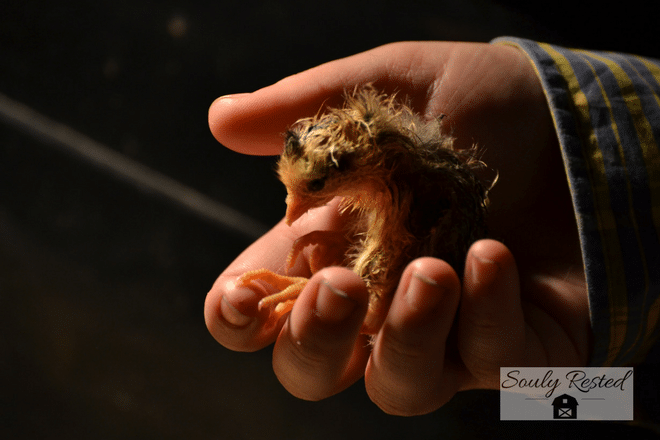
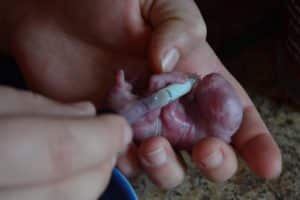
But I despise it when my foolishness kills animals in my care.
The most difficult aspect of animal death on a homestead is when animals die needlessly because I make a foolish mistake. Last month, a foolish thing I’d done for years, without realizing it was foolish, cost the life of a beautiful rabbit who was only days away from providing our family with a nutritious, farm-raised meal.
Yes, we raise meat rabbits. Rabbit meat is one of the most nutritious, healthiest options you can consume, especially if you have personally cared for the animal and know everything it has eaten. So we’ve raised them for years. We have many cages set up, needing to leave babies with mommas for many weeks, then keep males and females apart until processing. Beside our cages, we have a tall pile of bowls that we interchange in their cages, to fill with food and water. (A “perfect food bowl” is one of my favorite finds at the “give and take” room at our local dump. That and old cooking pans to line under their cages, to collect our “fertilizer.”) But never once did I consider choosing their food dishes based on if they were top heavy or easily flipped over.
Last month when I discovered a rabbit stiff, cold, and lifeless with his head trapped under one of those bowls and one of his peers sitting on the upturned bowl, well it was one of those distinct times when I logically thought through the process of how I could quit this homesteading life. Get off the homesteading bus all together. Give away the animals and move to a new life.
I cried big tears that made warm tracks down my cold cheeks as I cradled his stiff, sad body to the marsh to dispose of him. I did a lot of praying on that journey through the cow’s pasture and down a wooded slope, asking God why this way of life has to be so very hard sometimes. Asking Him why I have to keep on orchestrating so many bitter blunders.
After praying more and talking things over with my daughter, I came to the decision that for now we will keep on keeping on with meat rabbits. Maybe someday it will be time to take a break from raising rabbits, or ducks, or hens, or dairy cows, but I am certain that, for now, homesteading is the difficult but rewarding way of life I am supposed to be living.
But the #1 reason I would consider giving up homesteading? I explain the #1 reason I would ever consider giving up homesteading in this post.
My Solution to This Difficulty?
Our pile of dishes by the rabbit’s cages is much smaller. I went through and tossed all the ones that the rabbits would be able to get their noses under and tip over. So hopefully this foolish loss won’t happen again while rabbits are in my care.
I also decided the best I can do, for now, is to keep on learning from my mistakes and keep on sharing them with you.
And I’m grateful that many of you have told me how my huge mistake with my rooster saved many of your hens.
My learning experience with my broody hen helped you train a hen to adopt new babies.
And my failure at hatching eggs helped you incubate successful flocks.
So there is benefit in the sorrow. For that I am extremely thankful.
In my next post I share the #1 hardest aspect of homesteading, in my opinion, and my best solution I’ve come up with for that one too.
And in this fb live I have an open, honest chat with you about some huge difficulties I’ve recently faced and yet another reason that homesteading is really difficult for me at times…
Other Homesteading-related Reading & Podcasts:
Listen in to the Old Fashioned On Purpose podcast when I share why homesteading matters & why I initially had a difficult time with the transition from suburbia.
Check out a dozen mistakes we’ve made on our homestead and how you can avoid them.
Then there’s 8 Things Wanna-be Homesteaders Need to Know.
Recovering from Homestead Hardships
Pin this for later!
Click on an image below to pin this post.

Find out why SoulyRested was considered to be one of the Top 20 Must-Read Homesteading Blogs of 2018 and then one of the Top Homesteading Blogs of 2019 as well.
I’d love to connect!
To find me in some other neck of the woods, just click any (or every!) icon below:
And please follow along!


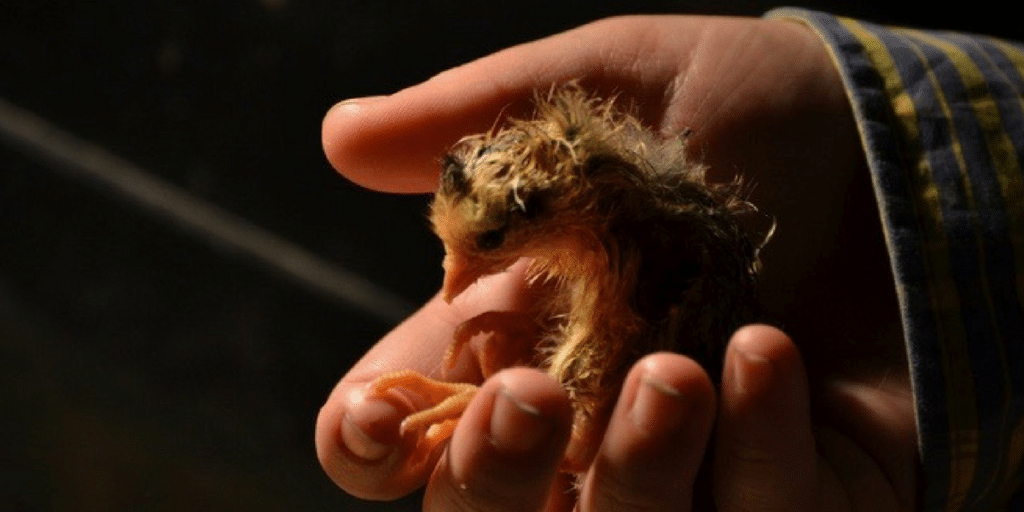
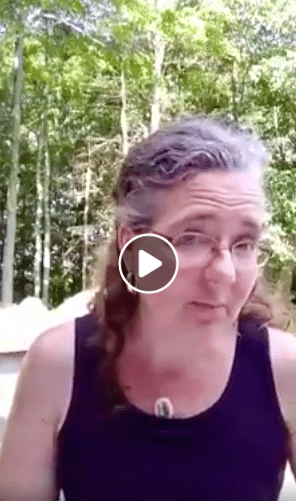
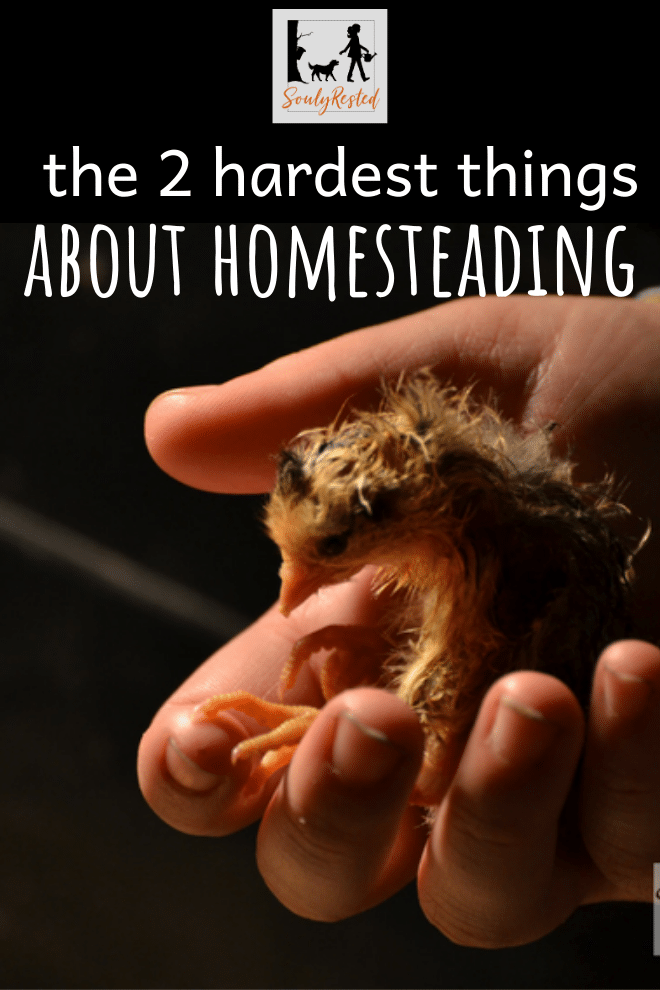





I agree that death is one of the hardest things to deal with. I occasionally have days when I think about moving back to town, or at least closer, but that usually passes. The country life has so many more good things to offer.
You might try putting a big rock in the middle of the pans so they can’t flip them over……I do that in my bird bath so the squirrels can’t flip it over and spill the water…………..love your column and always look forward to reading it…………yes, I try to remember to always thank the Lord for this animal that gave it’s life to nourish my family………
Great idea about the rock, Pat, but it would also make it more difficult to drag the water bowls out of the cages for refills. For now, tossing all the bowls that appeared to be “tip-able” is doing the trick. And thank you for your kind words. I’m glad you find some joy and benefit in my musings and ramblings. 🙂
I also make mistakes, like the time I put my sweet breeder buck in a cage on the ground for fresh grass. He was spooked by the dog and jumped in fear, breaking his own neck at the top of the cage. Sad day. Even with our mistakes, our animals have better lives than the factory farmed animals. I have a question on your meat rabbits. You reference seperating the males from females until processing. Why do you seperate them? I leave my grow outs together until I process them. I have never seen any bred. Im just wondering for sharing of ideas. Thanks!
I would have NEVER seen that coming. I know our dog, unwittingly, often startles the rabbits when he’s going through the barn (where their cages are). But I would have never thought he could startle them in such a way that one would die. That’s really tough. I was heartbroken over loosing one that I was going to process for meat in a few days, and I had no attachment to him. Loosing a sweet breeding rabbit would be much worse. As for separating them, we always have, just to avoid the off chance of one of the females being bred. While we should process right at the 8-10 week mark, we don’t always, and I assume they could easily be mature enough to be bred by the time we process them sometimes. But honestly, it’s just something we’ve always done without questioning it. Now that YOU have questioned, I did some research and I guess there’s no need to do so unless we wait a whole 5 months to process, which would be crazy. (They would not gain in size and the cost per pound of raising them would be exorbitant.) Hmmmm, maybe I’ll skip this effort next time we have kits.
Thanks for the reply, its always good to share ideas and why we do things differently. We might learn something new! I’m glad I found another rabbit meat enthusiast, rabbits can be such an economical and easy source of meat for both the small scale backyard homesteaders and large farmers alike.
We also process our rabbits pretty young. I never follow a certain time line or age to process, more like when I look out the window and say “the rabbits look big enough and its a good day to process, lets do this”
Have a great day and stay warm in this frigid weather!